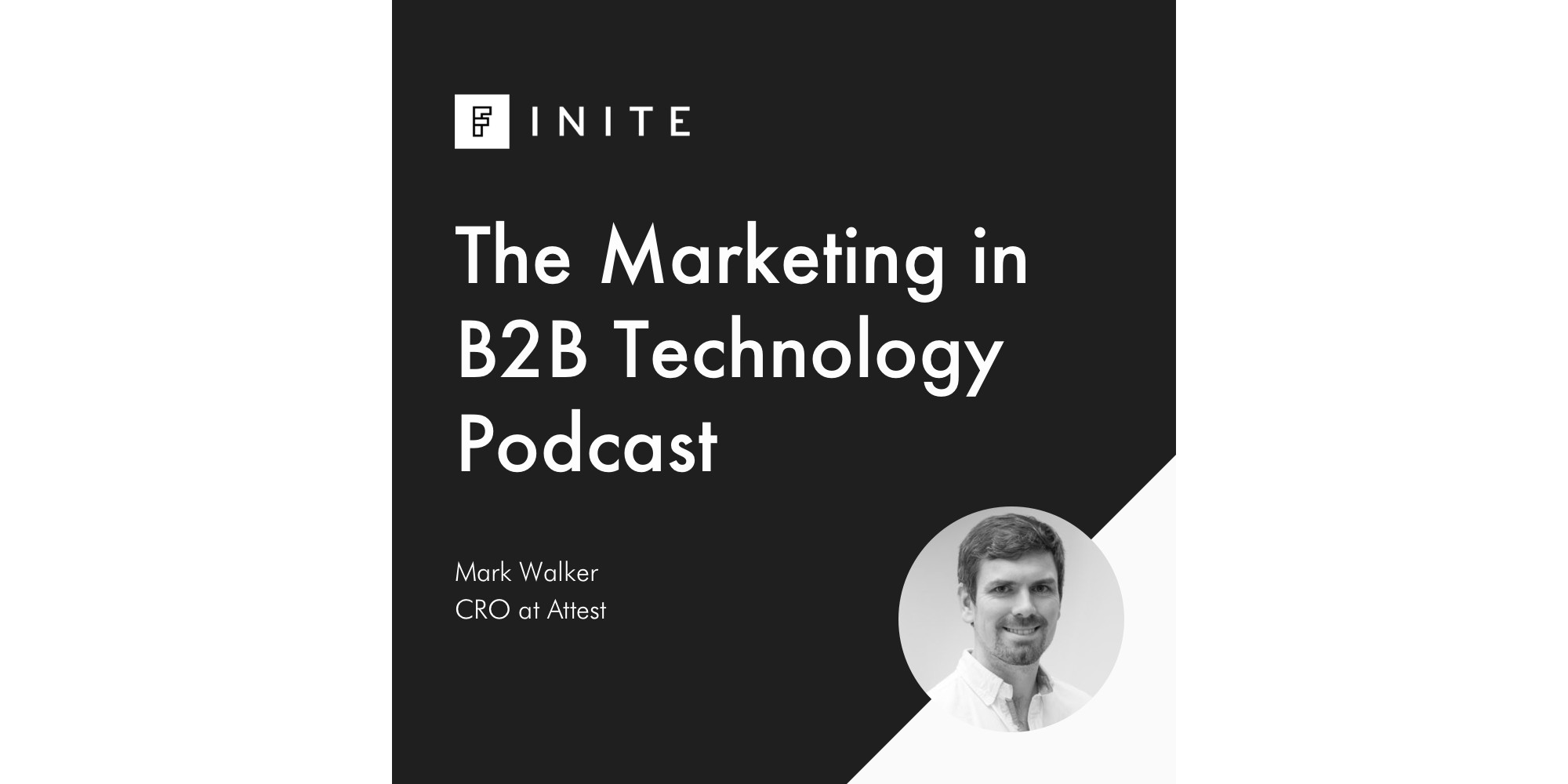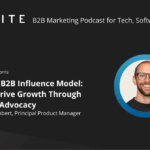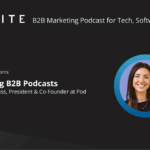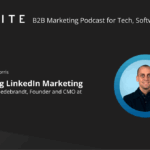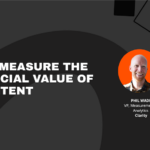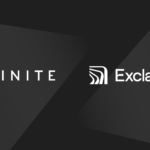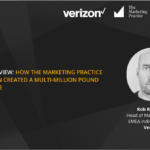Mark Walker is Chief Revenue Office at Attest – a technology platform that allows businesses and brands to ask consumers questions, analyse data, and discover insight all in one end-to-end platform.
Our host Alex Price sits down with Mark to explore what his role as Chief Revenue Office at Attest encompasses, before discussing the topic of balancing brand and performance marketing and asking big questions such as are B2B marketers too obsessed with data?!
This episode covers:
- About Mark and his role at Attest
- About Attest as the solution to gaining brand insights
- The origin of the tension between brand and performance marketing
- Why you shouldn’t throw all your budget into advertising
- How a CMO should address long term brand building
- How Attest balances brand and performance marketing through content and data
- How quality content builds long term brand value
- The enterprise sales cycle of Attest
- Working with media partners to diversify performance marketing
- How to attribute ROI to performance marketing
Listen to the full podcast here:
And once you’re done listening, find more of our B2B marketing podcasts here!
Full Transcript
Alex (00:07):
Hey everybody, welcome back to the FINITE podcast. So today I’m going to be sitting down with Mark Walker. Mark is the Chief Revenue Officer at Attest, a really interesting fast growth, scalable consumer intelligence platform that helps brands and agencies connect with millions of consumers and gather insights around their brand. And also do market research through a really intelligent platform.
Mark is Chief Revenue Officer, which is a really fascinating role that we’re seeing more and more of, oversees both marketing and sales at Attest. And I’m really looking forward to sitting down with him to explore that balance between brand marketing and performance marketing and how brand and data can work together, side by side. So I hope you enjoy.
FINITE (00:53):
The FINITE community and podcast are kindly supported by 93x, the digital agency working exclusively with ambitious, fast growth B2B technology companies. Visit 93x.agency to find out about how they partner with marketing teams and B2B technology companies to drive digital growth.
Alex (01:14):
Hi Mark, thanks for joining me.
Mark (01:16):
Thanks for having me, Alex.
Alex (01:17):
I mean, we’ve got lots of talk about spanning all kinds of stuff relating to brand and performance marketing. I thought we’d start with as usual, just a bit of an introduction to yourself and Attest and tell us a bit about what you’re up to day to day.
About Mark and his role at Attest
Mark (01:30):
Yeah, sure. So I joined Attest just over two years ago when we were around 10 or so people. And we’ve been talking since you got here about how we’ve just moved into a new office,
Alex (01:41):
It’s beautiful, yeah. Lovely view of the Shard behind me.
Mark (01:41):
It’s beautiful. It’s crazy how far we’ve come so quickly in the last two and a bit years. So from 10 people, we’re now around 60 and the office space caters to about 110. And the idea is that we’ll probably be filling it by the end of the year, which is kind of crazy growth. So yeah, it’s been really fun being here at Attest.
Prior to Attest I was the head of growth for UK and Ireland at Eventbrite for three years. And again helping to grow the commercial side of that business in the UK and Ireland. And then prior to that, I was also a startup founder for best part of 18 months. Couldn’t get the financial traction that I needed to go on and raise VC money. So eventually shifted that, but it was an amazing lesson in all kinds of things, in everything. And you know, all of these lessons and roles have obviously built up towards what I’ve been doing here at Attest, which is looking after the growth team.
Alex (02:36):
Cool, so you’ve got the chief revenue officer title, which we were talking about before is a really fascinating one for me. And one that I see coming up more and more. Tell us about how things are structured and what that role kind of covers and what’s underneath it as an umbrella term.
Mark (02:50):
So yeah, the chief revenue officer is definitely a role that’s springing up more and more. I think it, as many of these things, it started in Silicon Valley, it’s been brought over to the UK. I mean, the idea is just to have more connectedness across particularly, well originally it was across the marketing and the sales teams. I guess it’s all about having a consistent experience for clients and also make sure you’ve got the right communications and shared goals across those different teams.
So here, the way we have it structured is we have a content and product marketing team. So they look after kind of sales enablement. They look after the blog content creation, as I mentioned, product marketing, and they’re kind of like this horizontal platform across the business, creating the foundations for everyone else to be successful. And then we have demand generation, so demand generation, and obviously lead generation is one of their number one metrics, but they also look after our tech stack and they kind of have a sales operations aspect to that team, which we talked about as another team that’s starting to break out into its own.
And then we have the SDR team. So business development, trying to qualify new prospects that are coming in from inbound marketing, as well as doing some external prospecting as well. We then have the new business team account execs looking to close new business and new logos. And then we have an account management team who are obviously onboard and make sure our existing clients are happy renewing and looking for expansion opportunities as well.
So we have those five teams and they all work together. We all have a shared goal. We all have a Monday meeting all hands to make sure everyone is aware of what everyone’s doing and really that’s the point of this role. It’s to kind of coordinate multiple teams, all sharing a single goal and all moving in the same direction.
Alex (04:38):
Interesting. That’s pretty cool. Tell us a bit about what Attest actually is.
Attest as the solution to gaining brand insights
Mark (04:41):
Yes, absolutely. So Attest were founded four years ago by Jeremy King. He’d spent nearly 10 years at McKinsey working with kind of blue chip clients, a lot of consumer brands across an awful lot of different industries. And during his time there, he noticed that businesses that were really consumer centric and really aspired to stay close to consumers were the ones that typically outperformed others, but equally ran into this frustration all the time of not being able to get consumer insights into the right people across the business whenever they needed to make decisions.
So all too frequently, he’d be sat in a boardroom with people who were trying to make big decisions and they weren’t based on anything other than maybe kind of an outdated market report from 18 months ago and broadly intuition and gut.
So Attest is here to try and change that, right. We want to make it easier for all stakeholders across the business, not just research and insight teams, but anyone that’s making decisions that impact consumers to have the insight and the research necessary to make better decisions and do it at the pace and velocity that modern businesses need to do it.
And that’s what Attest is all about. So it’s empowering people to have the insights and the consumer data to make better decisions. And I think there’s one interesting stat that I didn’t have until only a few months ago, but it really illustrates the size of the opportunity that we have as a business. And it’s from a report from PwC. They do an annual survey of CEOs, of generally larger companies, multinational companies. I think they interviewed about 1200 of them. And 10 years ago it started and they asked about the critical data needs that CEOs saw across their organisation.
And the number one critical data need that CEOs had 10 years ago was better understanding consumer needs and wants. And they saw that as a critical success factor. I think like 95% of CEOs said that’s the number one thing they need. And at the time 23% said they felt their business was well equipped to get that data into the business. 10 years on, the number of CEOs who find it critically important has gone up to 96%. And the number of CEOs who think their business is equipped to get that insight into the business has gone down to 15%. So there’s this insane gap. And Attest is there to fill that gap.
Alex (07:04):
Interesting, fascinating stuff. So today we were going to talk about, I’ve kind of described it as brand versus performance. I’m not sure, maybe I’m part of the problem by putting versus in the middle but, I guess setting the scene, why is there even this tension?
I know you’ve talked about it a bit before and you’ve got some views, so I guess for anyone that’s not familiar, I guess it’s probably hard for people who are in the marketing world to not be familiar with a bit of the tension that might exist between brand led marketing and performance/data led marketing, but why do we feel like there’s even a debate between the two and this tension?
Why there is tension between brand and performance marketing
Mark (07:38):
Yeah. So I think performance marketing’s been around for a long, long time in the form of direct mail, for example, and even tele marketing. Like that’s kind of performance marketing, the stuff that you can do at a granular targeted level and see the response rates, attach clear numbers, you can measure the ROI. And of course, brand has been around for a really long time.
So these aren’t necessarily new camps within marketing, but what was it 10, 15 years ago, and with the rise of Facebook and Twitter and all the new social networks, and as they became platforms that allowed marketers to acquire consumers, that’s really where this kind of debate between brand and performance marketing has arisen, because certainly early adopters saw incredible returns, right?
From Facebook marketing, LinkedIn marketing, Twitter marketing, and you suddenly had an incredibly easy to measure marketing channel, which then meant people started to funnel pounds and dollars into it. And also they were kind of the shiny new toys, they were exciting. And it felt like if you weren’t investing heavily in them, you were going to get left behind when your competitors were doing. And actually I think for a long time that was true, because so many consumers were on those platforms and relative to the number of brands taking advantage of it, it was really, it was like shooting fish in a barrel almost.
But 10 years on everyone is on those platforms. And actually consumers are starting to wane a little bit in terms of how much they want to interact with brands on those platforms. So anyway, going back to the brand versus performance, I think what’s happened is over the last 10 or so years, so much budget has been allocated to performance marketing to the point where you see the stats every year that Facebook and Google are this duopoly taking up 80% of all digital spend, which is tens and tens of billions of dollars and that’s performance marketing. So they’ve kind of elbowed out almost everything else.
And yet performance across the business, I think hasn’t necessarily kept up with that level of investment. And so people have probably started to question whether they’ve pivoted too far into performance marketing and let’s not forget about creativity and brand building. And that’s where we’ve now got the two camps.
Alex (10:02):
I think a lot of stuff on the more big ad agency world, you see people quite regularly at the top of those agencies, writing things about how creativity is dead, and there’s a more pure creative side that they think is we’re living in sad times where the creative idea carries no value anymore. And then within the more marketing, digital marketing focused area, there’s the same kind of lack of, people feel like they’re going to win when they’ve got data behind them. And I think that’s true, right?
If anybody goes into a boardroom with a spreadsheet, they’re going to win potentially over just a big creative idea when they’re asking a CEO or someone in the C suite for a big chunk of budget to go and execute on something. You mentioned the fact that it was easier to some extent, do you think that’s been a big driving force? It’s just the fact that it’s easier and getting easier, you can spin up a LinkedIn ad in minutes now. Is it just the fact that it’s too easy, it’s kind of the short term easy option and nobody’s really worried about the longer term thinking?
Balancing ad-spend with long term brand building
Mark (11:04):
Yeah. I think it is easy as a business to get addicted to that dopamine hit of putting something live. Suddenly you’re growing your followers, you’re getting the likes and seeing your click through rates, it’s instant gratification. And in many respects, it is easy and it’s very easy to see the return and it is going to be hard to say, look we’ve created X amount of new business off the back of performance marketing this year, but we’re going to reduce the spend to do some long term brand-building. I mean, that is a really hard business case.
So now, Pandora’s box is open and people have invested that amount. It’s very difficult to turn this around. But I spoke at Media360 earlier this year with Claire Cronin, who’s the CMO of Virgin Atlantic. And it was just a fascinating case study where they had done the same pivot as a business and Ed Von Herds pitched hard for digital and how it would help make everything more efficient and measurable and trackable, et cetera.
So over a four year period from about 2013 to 2017, they reduced budget hugely in TV and creative spend and put it almost all into digital. But during those four years, they kind of lost familiarity, brand awareness. I think brand familiarity went down from something like 83% to 63%. And awareness, it was something like 98, even 100% down to about 91, 92%. And so three or four years later, people couldn’t quite believe that they were able to drop so far as a brand in such a short period of time. It’s not that they were spending less money in total, they were just spending money in different areas in digital.
So one of the things Claire has done since she’s taken over as CMO is redress that balance. And although it’s going to be a long road, she’s been able to show that through long term brand building and reassigning budget to creativity, to TV and above the line, they’ve actually driven an incremental lift. And I think it was something like 150 million in profits. So you can prove the value of long term brand-building.
And this is one of the things that Attest can do, so we can help measure the brand awareness, familiarity, consideration, purchase intent, all these leading indicators that businesses have almost forgotten about because they’re focused more on likes and followers and click through rates, but actually there’s another metric. And another KPI that business should be aware of, particularly if you’re not purely an online business and you are going to sell through retailers or the high street, they’re really important metrics. And if you’re not following them, yes, it’s going to be hard to justify the investment in brand building. But if you are, you can start to find metrics that show your investment is showing a return.
Alex (14:01):
Yeah. I think this kind of relates to, you’ve touched on the KPIs and the things that are being measured in the business, but I guess we’re saying then that it takes a pretty fundamental shift and a lot of clarity from the top of the business around what’s important for a marketing team. What they should be working towards. I think I also often just see decks that go round to leadership teams at the end of a month or something. And it’s got this campaign on LinkedIn generated this many MQLs, whatever it was, but you know, there’s no slide deck on there that says our net promoter score at the end of this month is this or brand awareness was this.
And I think particularly in the B2B world brand is, I guess people think it’s not as important, like the emotional side of decision making and B2B is for whatever reason, kind of slightly sidelined. So I think that data driven approach is creating the short-sightedness and unless those KPIs change, where is the business going to be in three years or five years?
And people are taking that long term view, but then I guess, you know, when you look at the average tenure of a CMO or something, it’s about three years? Or if that, I think in some cases, so I guess it’s quite a fundamental thing. If people are obviously out to do a good job and want to progress and move on then, are they necessarily incentivised to be looking at the five-year picture or the 10 year picture?
How a CMO should address long term brand building
Mark (15:19):
Yeah, it’s absolutely right. And yet at some point, you know, I guess if it’s a bit like musical chairs that, you know, the music will stop and whoever’s in that position will have to address it. So yeah, I think it’s important, you know, averages lie, right? So there could be a few CMOs who are out on their ear in six months or a year, and yes, I think the average tenure has continued to go down, but C suite positions should still be thinking about long term value creation, you know, three, five, seven years and beyond.
And even if the CMO is, and the CEO should be holding them accountable to make sure that they’re not selling the long term vision short. And really, I think, again, a really great example of this came earlier this year with Kraft Heinz. So they announced, I think it was around April time that they’d fundamentally lost touch with consumers and were no longer as resonant as they once thought they were. Now a huge amount of their value is a business and their market cap is tied to intangibles, which fundamentally comes down to brand value.
So on the announcement of this, they essentially had to write down $15 billion worth of good will, which was there intangibles and brand value, 15 billion, which got wiped off their books, just like that overnight. And then their share price crashed down 28% again, over the course of a week. I think within two weeks the CEO was gone and they were looking for a new CEO and one of their biggest kind of PE investors, 3G, their CEO, Jorge Lemman, I believe his name is, kind of had a bit of a mea culpa. And he said, look, we invested in this brand and thinking it was never going to go away. And so we didn’t invest enough in continuing to understand consumers and consumer sentiment and building the brand.
And now their new CEO is the ex CMO of Anheuser Busch, so they’ve kind of understood the value of brand building long term value creation, but it’s come at an incredibly expensive lesson for them. And I think for brands who don’t want to be in that position, it’s just important to remember that particularly as a public company, and if you are a consumer brand, a huge amount of your market cap is going to be tied up into intangibles and brand value.
So you’ve got to continue to look after that as well as your top line sales growth. And there’s, to anyone that hasn’t read it, I think it’s really important for people to go and look at Les Binet and Peter Field. And they’ve done a lot of work over the last 10 years or so in looking at how to prove the efficacy of brand building versus performance marketing.
And so I think that they were the ones that really have made this a C suite, C level debate, let’s say, and have the numbers to back it up. And they’ve essentially found that if, they’ve done a lot of econometric studies and across a broad bucket businesses and industries. So the specifics will differ, but broadly across all of them, I think they found the optimal level of investment is 40% performance marketing, 60% brand building. And then they’ve just released a new study specifically for B2B, which was sponsored by LinkedIn. But assuming that it was done completely independently, they found a not too dissimilar ratio.
It’s actually inverse for B2B. So it’s more like 60% performance marketing, 40% long term brand building, but I’d be surprised if many B2B tech brands are spending 40% of their budget doing brand building.
Alex (18:47):
I would agree with that. Yeah, absolutely. I mean, it would be good to talk a bit about how you do it for yourselves and obviously you’re delivering all this technology for clients. It’s giving them a lot of insights and I assume you’re kind of to some extent practicing what you preach.
I mean, how are things structured for you? Not necessarily directly the split of budgets, but obviously you’re doing inbound, you’ve got a demand gen type team. I assume you’re running campaigns and ads and all the different platforms and stuff. Can you tell us a bit about how it works overall?
How Attest balances brand and performance marketing
Mark (19:13):
Yeah, sure. So we do invest in brand building. Absolutely. Cause I just fundamentally believe in it. I mean the numbers stack up anyway, but to an extent you do sometimes have to believe in these things and again, give them a chance to prove out over time.
Alex (19:28):
Importantly on that point, you’re obviously in a role where you’re empowered to have those beliefs and that’s okay. And I assume you’re working with a CEO and founder that is supportive of that view. And because I think that’s often the barrier for people is that no matter how strong willed the marketer might be, and how senior they might be, if they have to go to a CEO and a CFO and try and justify these kinds of things, it can be quite a tough thing to do.
Mark (19:52):
Yeah, absolutely. So, Jeremy is an incredibly supportive CEO and has empowered all of his direct reports to make the right decisions based on their expertise, which has been enlightening to say the least. And so he’s been very supportive of what we believe is the right track to take. And so has the board in general, they’re supportive rather than directive. And I do think that’s, I mean, it’s one of the joys of working here, but I do also think it’s why we’ve been able to grow so quickly because you don’t have too much of a top down approach.
Everyone’s allowed to get on with doing what they know best how to do. Yeah, that’s incredibly important. And I do feel for anyone who doesn’t have that ability, you know, they believe or know it’s the right thing to do and can’t get the sign off, that’s pretty tough. But honestly, again, we’ve got various bits of content across Attest, which if you go onto the blog and kind of search for it, we’ve got a bunch of stuff to help support those decisions.
And there’s more and more data coming out to not just go and say, hey I believe we should be doing brand building, but actually the numbers support it. Here’s a bunch of case studies, and here’s what happens if you don’t do it. So yeah, I guess going back to what we do here, we invest in a bunch of things that aren’t directly performance marketing related.
So we have a quarterly magazine, a print magazine, which we mail out to clients and other people who sign up for it. So I guess prospects, and again, you could argue that’s old school direct response, but it’s not really, it’s a fairly thick content driven magazine. It’s not a flyer that’s trying to get a piece of direct response. And so, although we do get some nice social media posts around it, and occasionally you can tie it back to someone calling you or inbounding because of the magazine. It’s more brand building than anything else. It’s something you can take to events with us and drop off to prospects.
Alex (21:50):
So it really is about quality. Cause I think it’s so easy for brands or B2B businesses these days to write a one side white paper and chuck it behind the gated content form on their website, and then assume that they’re going to get loads of leads coming in off the back of it. But quality is still the most important thing.
How quality content builds long term brand value
Mark (22:06):
It’s so important. And again, I think it’s just, you know, for us it’s a belief in investing in doing good work and doing stuff that’s going to broadly impact and help consumer brands who are our clients. Well, whether they’re our clients or not, right. You know, we’re in this space and we want it to become better and more educated. And the magazine’s a part of that, we do a lot of events.
So we speak at events, we sponsor an exhibit at events. We run a lot of our own hosted events. We do workshops, panel sessions, lunches, all kinds of things. And again, there’s always an element of hoping to get some leads, but that’s not, you can’t justify that level of spending purely on lead gen. You’ve got to be thinking all the time this is helping build our brand and our reputation.
And it’s amazing how frequently six months down the line, or nine minutes down the line. So it completely breaks the funnel, but we’ll have someone come in and say, oh yeah, I heard you guys speak nine months ago. My colleague heard you speak and now they’ve told me about you. And now it’s about ready that we’re now in market for what you guys do. And that’s brand, that is not performance marketing because performance marketing, if you’re not generating a response within 30 days, let’s say max 90, it’s not performance marketing. It’s coming down to brand-building and long term value creation.
Alex (23:25):
That’s really interesting. So what’s a typical, cause you’re selling mainly to enterprise brands. I assume you’re taking them on quite an educational buyer journey that takes time. And then I assume when you get into the kind of conversations of, they might be interested, there’s a lot of people at their end that need to be involved from product, technical, all kinds of different roles coming together. What’s a typical sales cycle? And how long does it last from that first getting in touch through to actually having implemented in and gathering insights?
The enterprise sales cycle of Attest
Mark (23:55):
Yeah. So again, average is a funny one. So we’ve done some deals that have closed. My favorite was this quarter, we did a deal in two days, amazing. And we’ve done another previous quarter in six days. Some have taken six months. So on average, it works out at about 45 days, which is pretty quick for the deal sizes that we’re doing. And again, it’s kind of testament to once people get what we’re doing and we can get over the education piece, it then runs really, really quickly. Because again, there is a huge need for this.
And I think one of the best and most difficult things about Attest business is we set out two years ago to try and create a category and sell something to people who’ve never bought this thing before. So that’s tough because it requires a lot of education and it does mean trying to find budgets that haven’t already been allocated to it. So they’re the tough bits.
However, once you’ve sold someone senior enough, they can find the budget, you’re not competing against anyone else, which is amazing. So you’re not coming up against people in 12, 18, 24 month contracts, which you might typically do in an enterprise sale. And you build and nurture that, and it can take two years to win. And often again, if we sell to the right stakeholders, which are typically CMO, marketing director, they’re able to sign off on something if they think it’s strategically valuable to the business fairly quickly.
So yeah, it’s a surprisingly fast sales cycle. Albeit we do have the odd one that can come in after six months. They’re really satisfying too.
Alex (25:35):
I imagine yeah. So what about on the performance side for you, the kind of performance in air quotes. You’ve talked about a bit of the content and other kinds of things that are more brand building around events. What do you do then? How do you then approach the paid acquisition channels or other kinds of performance channels?
Working with media partners to diversify performance marketing
Mark (25:52):
Yeah. Again, we try and diversify across different channels. We use Facebook, we use LinkedIn quite heavily, would probably be our number one. We have PPC on the go, which is. When it works, it’s really valuable, but for what we do, it’s pretty niche. Again, it’s a new market. There’s not a great deal of search volume. So, you know, finding people that are in market for a few key needs, you know, it can work really well, but it’s probably never going to be our overall core driver.
But one of the, again this comes down to trying to balance between brand and performance, but we work with a lot of third parties in our space. So titles like Adweek, Marketing Week, Campaign, The Drum, we work with them to run a number of different initiatives, some of which are more brand-building and some of which are performance related, but they have the audiences that we’re looking for. And while something like LinkedIn, it’s exciting because it’s scalable, it’s global, et cetera. You know, it could take all of your money if you let it.
And so it’s good to diversify and work with other partners in the ecosystem as well, because I love what those titles do, you know they’re investing in good journalism in their own brand building. They’ve built up these communities over decades. And it’s just great working with them. I mean, don’t get me wrong. It’s great working with LinkedIn. We’ve got great account managers there and that kind of stuff. But I think it’s important to kind of spread your investment across different types of channels.
Alex (27:20):
We’ve talked about the fact that it feels like you’re pretty free to make decisions based on your experiences and kind of steer the ship in the right direction. When it comes back to actually doing elements of attribution and reporting, and you mentioned you’ve got a weekly growth meeting and those kinds of things, are you able to say, this is kind of what we attribute to brand, to some extent, this is what we attribute to performance?
How to attribute ROI to performance marketing
Mark (27:45):
No, not yet. Which goes back to the faith piece. So there’s enough anecdotal evidence that as I said, comes in via an inbound email or an inbound phone call where someone will say, they will qualitatively say, I heard about you guys through your magazine. Or my director passed this on and we heard about your event. It can’t be assigned performance marketing because it’s just completely outside that window. And again, we get enough referrals from people that we know that that brand is starting to come out there.
Again, another element of brand that’s kind of unexplored, but vital for business like ours is employer brand. So as we’re trying to now scale and build a team really quickly, it’s starting to pay absolute dividends and people in our space have heard of us and they’ve heard we’ve got a good reputation and good products and are keen to then join the team. So that’s another, it feels unrelated, but if you can’t get people in fast enough to then meet your growth goals, you won’t meet any of your other business goals as well.
So brand is really a 360 piece. It’s not just about acquiring new clients or leads it’s across the whole business. But going back to your original question, we definitely want to get there. So we’ve just rolled out a completely new tech stack across Salesforce, Pardot. We’re looking at implementing even more different technologies to kind of tie everything together. And that’s been looked after by the demand gen team, but that is a, sounds like such a funny thing to say, but it is a journey that we’re hoping to get to a point where we can start having slightly more sophisticated attribution models, probably towards the end of this year.
But in the meantime, we’re in a privileged position where we can go on a little bit of a faith, anecdotal evidence, and fundamentally the business is growing at a rapid enough rate that we don’t have to be looking for tiny percentage tweaks in optimisation at this point. We’re just growing, which is brilliant.
Alex (29:42):
Cool. That’s really interesting. So Salesforce, Pardot is kind of the main. Were you using Salesforce before?
Mark (29:48):
No we moved over from HubSpot.
Alex (29:51):
Okay interesting. And so I assume sales and account execs and stuff, hopefully if they’re doing their job properly, are keeping their CRMs tidy and dates are in the right place. That’s where you’re kind of capturing the anecdotal lead source type stuff at the moment.
Mark (30:06):
Yeah. Well that’s where we’re capturing it for long term, but not everyone has access to Salesforce. So we also make a heavy use of Slack to announce those things to the rest of the team. Because again, it’s good for the rest of the team to see actually this is a brand that people are talking about.
You know, some people are excited about financial growth, but a lot of people in the business care more about the broader brand of the business and the product and our reputation rather than purely the numbers. So it’s really important to tie what we’re doing back to again, overall growth of the business and reputation rather than just all about lead generation or revenue growth.
Alex (30:43):
And now Salesforce have just bought Tableau so soon I’m sure you can have some nice, pretty dashboards up on the screen with all the data.
Mark (30:49):
Yeah. That was a big, big purchase. I used Tableau back at Eventbrite, but it’ll be interesting to see what they do.
Alex (30:57):
Yeah, cool. Mark it’s been a pleasure. Thanks so much for giving up your time. Really interesting insights. So thanks very much and yeah, hopefully we’ll see you at a future FINITE event.
Mark (31:07):
Looking forward to it. Thanks Alex.
FINITE (31:10):
Thanks for listening. We’re super busy at FINITE building the best community possible for marketers working in the B2B technology sector to connect, share, and learn. Along with our podcast, we host a series of events here in London, so make sure you head to finite.community to subscribe and keep up to date with upcoming events.
